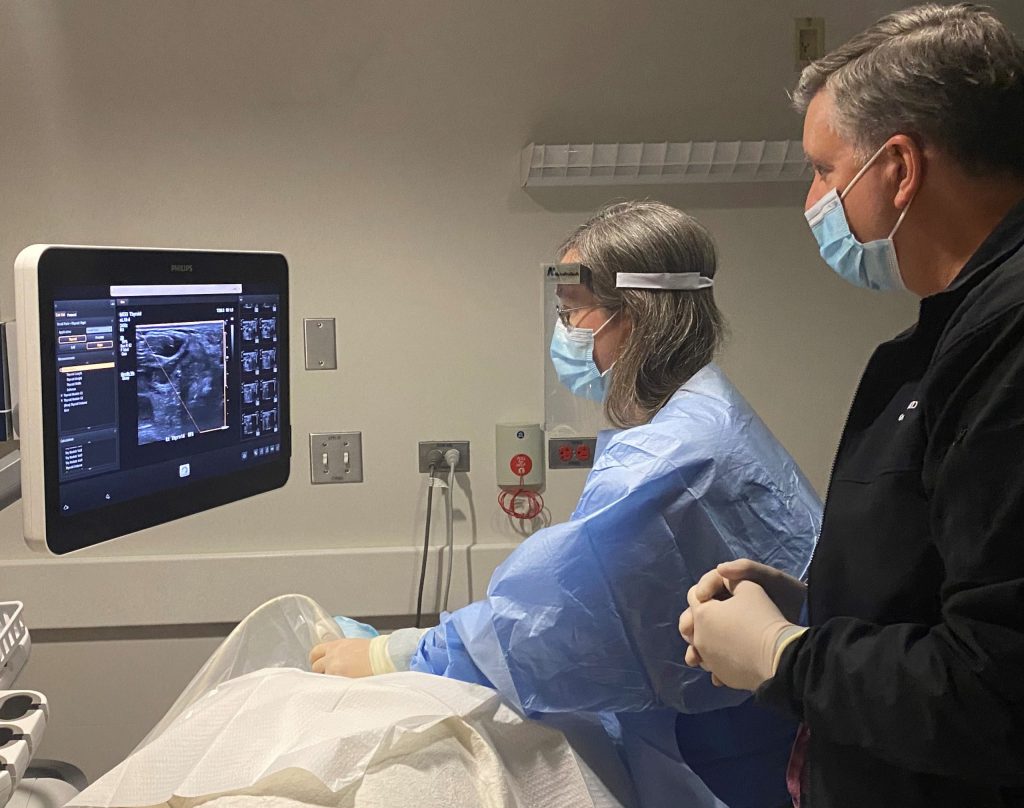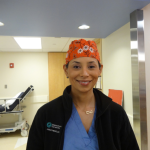Elite athletes train for countless scenarios. Cancer isn’t one of them. Jack Quinlivan turned to Mass Eye and Ear to help navigate thyroid cancer shortly after a concussion rocked his professional hockey career.

Jack Quinlivan doesn’t like to think about his first concussion. Few professional athletes do. The long, brown scar across his neck, however, affords him a unique perspective. Whenever he looks in a mirror, the scar greets the unpleasant memories of headaches, nausea and dizziness with an opposing emotion: Gratitude.
On December 11, 2022, Jack laced up his skates for the Worcester Railers of the East Coast Hockey League unaware of how a single hit he would soon endure would soon change his life. He had grown up in Shrewsbury, Mass., starring for his high school hockey team before serving as team captain at the University of Maine. He was living his childhood dream of playing professional hockey that day when a collision with an opposing player rattled his head and knocked him onto the ice.
The whiplash sent Jack straight to the bench. A few days later, when one of the team trainers ran their fingers down Jack’s temples to his shoulders, they suddenly stopped at Jack’s neck. The trainer had felt an odd bump under Jack’s skin. It felt all-too familiar to the trainer, who had undergone a surgery to remove a benign cyst not too long before then.
After diagnosing Jack with a concussion, the team insisted Jack undergo an ultrasound for the bump. Jack thought nothing of it at first. He just wanted to know how long his concussion would keep him off the ice.
“I remember thinking how ridiculous all this was for a little bump,” he said. “But it became hard not to assume the worst when they followed up for a biopsy.”
Within a few days, the concussion had become the least of Jack’s worries. He was diagnosed with an advanced form of papillary thyroid cancer. The full breadth of the disease—and whether it would forever derail his professional hockey career—remained a mystery until Jack met Gregory W. Randolph, MD, FACS, FACE, director of Thyroid and Parathyroid Endocrine Surgery at Mass Eye and Ear.
The tip of the iceberg
According to Dr. Randolph, papillary thyroid cancer is the most common type of thyroid cancer in adults. The malignancy begins as microscopic cells in the thyroid, a butterfly-shaped gland responsible for regulating countless metabolic functions, before it spreads to neighboring lymph nodes when more advanced.
How far the cancer spreads and the size of the cancer itself determines its severity. Cancers larger than a few centimeters can drastically increase the likelihood of a recurrence. Several layers of fat and muscle keep nodules hidden from the top layer of skin on the neck. A nodule large enough for a doctor to feel would raise an immediate red flag. It took only a few moments of meeting Jack for Dr. Randolph to know how severe his cancer was.

“I didn’t even need a scan,” Dr. Randolph remembered. “I could see the bulge from one side of his neck without having to touch it.”
As a world-renowned surgeon who operates on the thyroid and a separate set of pea-sized glands called the parathyroid glands, Dr. Randolph had removed hundreds of thyroid cancers in his career and even pioneered intraoperative techniques specific to both glands. But the size of Jack’s tumor, he would come to find out, was just the tip of the iceberg. A CT scan had revealed several chains of cancerous lymph nodes extending far beyond Jack’s neck. Some had reached as far as the back of the head, shoulders and upper jaw. One chain in particular had grown dangerously close to the spinal axillary nerve, which plays a vital role in controlling movement in the shoulder.
For ordinary adults, an impaired shoulder might impact a small part of their life, such as their ability to perform yardwork, complete chores around the house or play with their children. For Jack, such damage would limit his shoulder enough to end his hockey career.
Pinpoint precision
Dr. Randolph likens the anatomy of the neck to the inside of a house without lighting. The house has dozens of rooms, each with a podium hoisting a precious vase. Whenever Dr. Randolph enters the neck, he must know exactly where these precious vases—such as a ligament, nerve or muscle—are at all times. A misstep or wrong turn can easily knock the vase over.
The close proximity of the rooms inside the neck, and the hypersensitivity of the vases within each one, create a razor-thin margin of error for even the most seasoned surgeon. Millimeters separate converging nerves responsible for the voice, swallowing and tongue movement.
“It’s as if there are landmines everywhere, and I need to watch my step at every turn,” Dr. Randolph said. “Knowing exactly where you’re going can be the difference between years of a permanently damaged voice, difficulty swallowing, labored breathing and even tracheotomy.”
Treating a cancer as advanced as Jack’s would require a unique collaboration between Dr. Randolph and his colleagues in Mass Eye and Ear’s Department of Radiology. For such cases, he routinely works with Mary Beth Cunnane, MD, chief of Radiology at Mass Eye and Ear, to create 3D maps of patients’ necks prior to removing their thyroid or parathyroid. The maps rely on a series of ultrasounds and CT scans capable of pinpointing the exact location of cancerous nodules. Dr. Randolph tapes the map next to a computer screen at the start of every procedure. Upon entering the neck, he references the map and uses neuro-monitoring to keep all vital nerves and structures—including the spinal axillary nerve—safe and secure.
The 3D map of Jack’s neck revealed the full extent of his disease. A single surgery alone could not remove the entirety of the cancer without any complications. Jack needed two surgeries, instead.

A fresh outlook on life
By June 2023, the scar across Jack’s neck remained fresh and tender, as do the memories of his six months of treatment. Since his final surgery in April, Jack has gradually increased his cardio workload and returned to skating. He knows his “new body”—or so he calls his post-surgery existence—will take some time acclimating to, especially as he prepares his comeback to professional hockey. He takes hormone pills each morning to compensate for the loss of his thyroid. When getting dressed, he can occasionally feel the tug of scar tissue lingering in his neck.
His next appointment, marked on his calendar, keeps him grounded. There, he will undergo a final round of treatment: a radioactive iodine pill. Once ingested, the iodine will eradicate any remaining, microscopic cancer cells left over from both surgeries. To him, the pill represents a final hurdle in declaring himself cancer-free and the beginning of a personal mission to remind young athletes not to ignore any sudden oddities in their health.
“As an athlete, I get why you don’t want to press ‘pause’ after putting in years of work to try and reach the next level,” said Jack. “But cancer doesn’t wait on your career to unfold. I want people to hear my story, see their doctor and know they are taking the first step to avoiding a disaster.”
Dr. Randolph echoes a similar sentiment. He regularly sees young patients with similar cases and studies new ways of diagnosing and treating these cancers before they can rob individuals of their quality of life. His commitment goes far beyond his practice at Mass Eye and Ear, too. To date, Dr. Randolph has operated on at-risk patients from as far away as Chernobyl, Ukraine, Southern China and rural India.
While many patients walk away with a clean bill of health, many like Jack will have narrowly evaded disaster. And the scars on their necks become the small price of a lifetime preserved.



